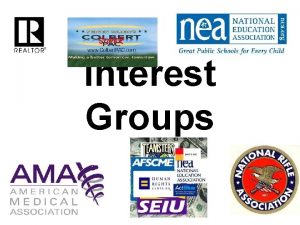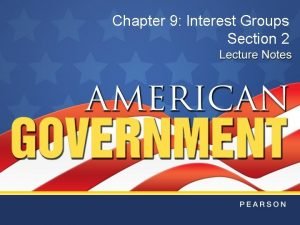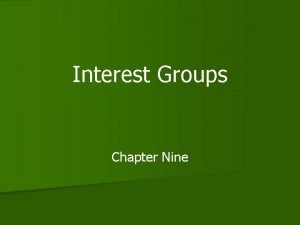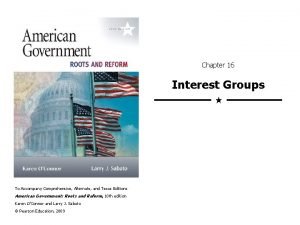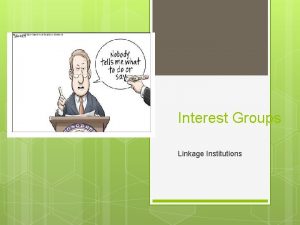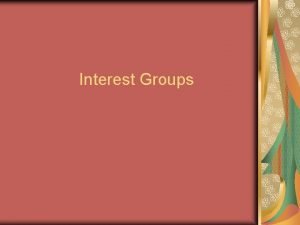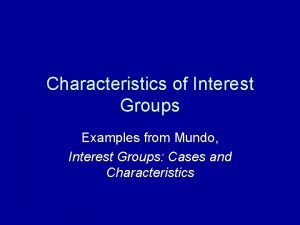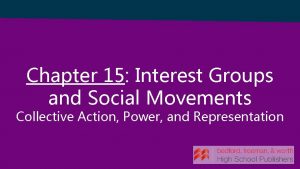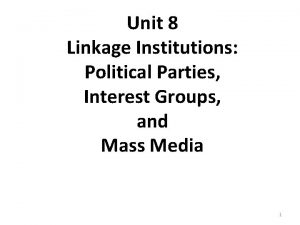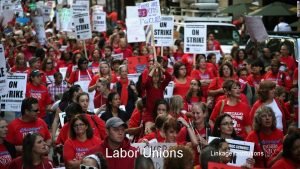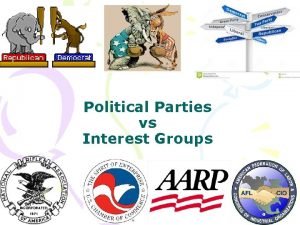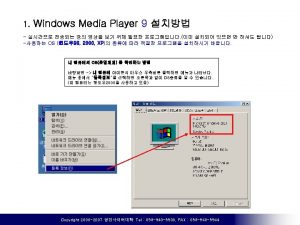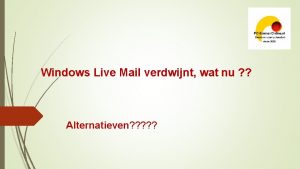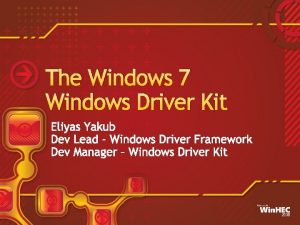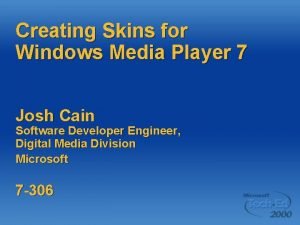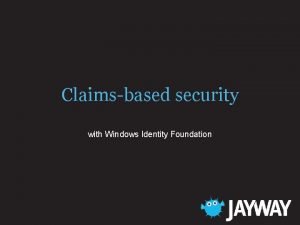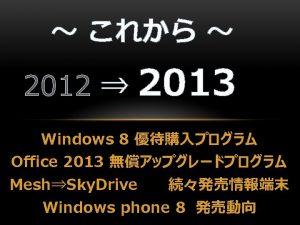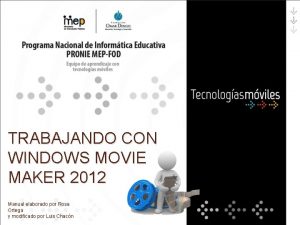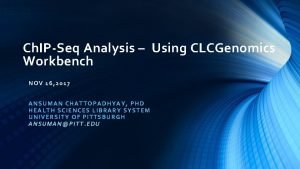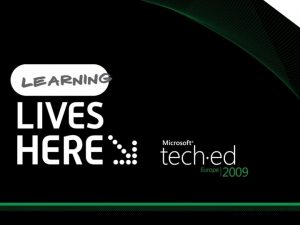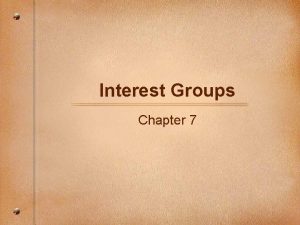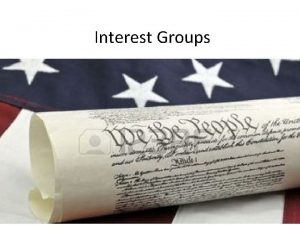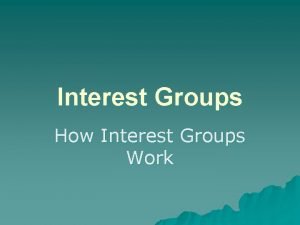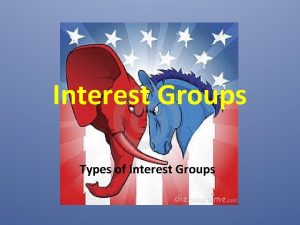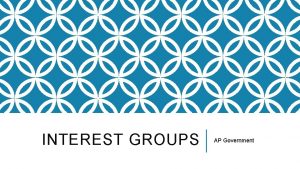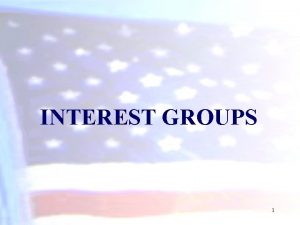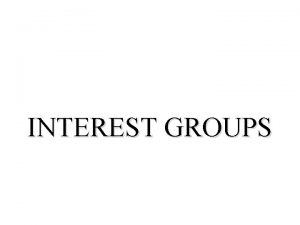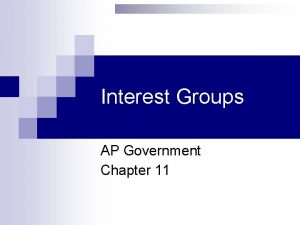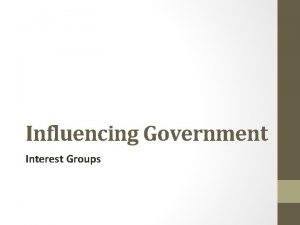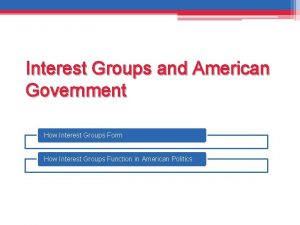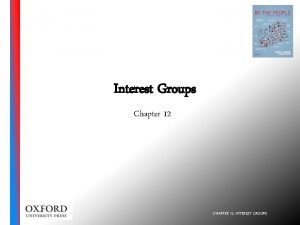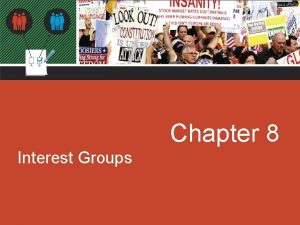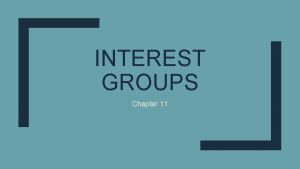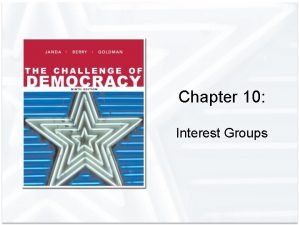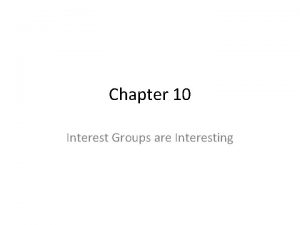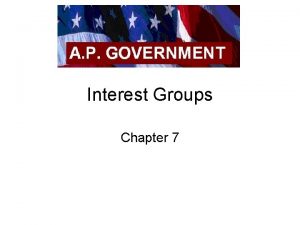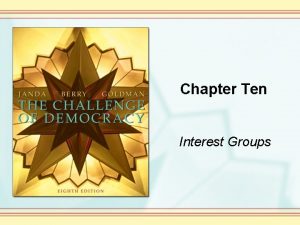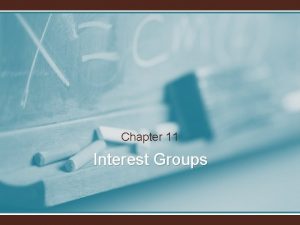AP GOVERNMENT INTEREST GROUPS Chapter 9 Ms Windows































- Slides: 31

AP GOVERNMENT INTEREST GROUPS Chapter 9 Ms Windows

What is an Interest Group? A group of individuals with common interests and seek to influence the government in some way (“Special Interests”) n Issue Advocacy n James Madison called them “factions” n

How does an Interest Group begin? n USUALLY an interest group begins as a movement n Examples-abolitionists, civil rights, women’s rights, animal rights, etc. n Movements start b/c people want their voices heard by ________ ?

Types of Interest Groups Economic (including Prof Assoc) n Ideological n Single Issue n Public Interest n Foreign Policy n Government Itself n Not all interest groups are mutually exclusive-some overlap into different types

1. Economic Interest Groups Businesses-large corporations (one person to large conglomerates) n Mc. D’s, Coke, AT&T, Microsoft, Amazon n Trade & Other Associations businesses with similar interest join together. n Chambers of Commerce n

n Workers associations or Labor unions • Represent workers’ interests • Membership is low in the US compared to other industrialized countries • Although entire work force increases, membership has decreased in last 60 years. WHY? • ALF-CIO has many unions, IBEW

Open Shop -membership in union is not required as a condition of employment n Closed Shop -must join a union to work n Either case, union negotiates for the workers n Free Riders -get what is negotiated for but do not join union n

Right to Work States (Open Shop)

n Professional Associations. Professionals form of a union. • Can be national or state • American Bar Association, National Education Association, AMA

2. GOVERNMENT Interest Groups Government employees want to be organized and heard n National Governors Association, National Conference of Mayors, National Education Association n Try to get federal grants! n

3. IDEOLOGICAL IGs n Ideological-specific political views or set of issues • MARXISTS, SOCIALISTS Civil Liberties, environment, nuclear disarmament n ACLU, Christian Coalition n

4. Single Issue IGs Single Issue (more specific) n Very adamant about position (right or left) and unwilling to compromise n NRA (2 nd Amend), Abortion -Emily’s List (PAC) v. Right to Life n

5. PUBLIC Interest Groups “for the public interest” n Common Cause -to reform the electoral process n Ralph Nader-PIRGs promote environmental issues, safe energy, consumer protection, good gov’t n

n Certain types of public interest groups are tax-exempt • Girl Scouts, American Heart Association, American Cancer Society • Benefits-donations tax-deductible, donors can remain anonymous • Cannot support candidates or elections but can do what? n Voter registration drives and issue ads

FOREIGN POLICY Interest Groups To promote or oppose certain foreign policies n Council on Foreign Relations, American-Israel Political Action Committee, National Association of Arab Americans n What would NAAA lobby for now? n

CHARACTERISTICS of Interest Groups 1. Size and Resources -the more, the better! n Motivations to join-incentives (material or otherwise) n What is the membership “spread”? Are the members concentrated in one area or dispersed?

2. COHESIVENESS -How is the membership organized? n Small # of leaders who have formal positions (full or parttime); OR n People involved in the group do all the leg work; OR n People are members in name only (no participation)

n How is the organization structured? • Strong, formal organization • Local groups that join together to form national group

3. Leadership -Strong or Weak? 4. Techniques -Methods they use to influence people and government n n n n Publicity/Mass Media Appeal Mass Mailing Influence Rule Making Litigation--USING THE COURT SYSTEM! Election Activities Forming Political Parties Lobbying Cooperative Lobbying (power in #s)

TYPES OF INCENTIVES Solidary incentives – sense of pleasure, status, or companionship (PTA, NAACP) n Material incentives – money, services, things valued in monetary terms (AARP) n Purposive incentives – the appeal of the group’s goals (ideological, public-interest) n

What are Lobbyists? Employees of an association that try to influence policy decisions and positions in the government n Revolving Door - moving from a government job to a lobbying job (common-good contacts already made) n A former gov’t worker cannot directly lobby their former agency or office n

What do Lobbyists do? Helps provide money for members of Congress for their next campaign n Provide two types of information: Political (who supports what) and Substantive (impact of proposed legislation) n

n Revolving Doors produce networks of people involved with certain issues. These networks are called IRON TRIANGLES or issue networks. • Mutually supporting relationships among interest groups, congressional committees, and gov’t agencies

Iron Triangle or Issue Network Congressional Committee Corporations Or gov’t contractors Gov’tal Agency

What are PACs? n n Political Action Committee is the political part of an interest group Can legally raise money for candidates or political parties from members, stockholders, or employees (of interest group) in number when the Campaign Reform Act 1974 limited individual contributions (over 4000 today) Individual candidates set up PACS – Sarah Palin

How PACs Invest their Money PACs invest in influential candidates (the Speaker, committee chairs) n PACs also give to important minority members because they never know when the balance switches in the House and Senate n

PAC LIMITS n n Federal Elections Campaign Act (1971) limits PACs to $5000 per election or $10, 000 per election cycle (primary and general election) OFT MONEY -PACs have no limits to contributions made to a political party for party-building purposes

Effectiveness of PACs Individuals can only contribute $2400 while a PAC can give $5000 n “Bundling” helps PACs get around the limits n Help campaigns through phone calls, mailings, and television n Issue Advocacy-promote or oppose a particular issue in the campaign n

527 Groups Tax-exempt organizations created to influence elections n Not subjected to the same restrictions as PACs n • Texans for Truth, America Coming Together

FEC and Interest Groups n Bipartisan Campaign Reform Act 2002 (Mc. Cain-Feingold Act) • Purpose to control $ that comes into federal campaigns and provide transparency for the $ collected n Mc. Connell v. FEC (2003) – 527 groups exempt especially for non -partisan issues, no regulation of internet ads

Honest Leadership & Open Govt Act (2007) n FEC developed regulations to limit the workings of lobbyists • lobbyists would bundle $ for a candidate • PACs now need to disclose lobbyists who bundle funds
 For or against
For or against Chapter 9 section 2 types of interest groups
Chapter 9 section 2 types of interest groups How are ethnic groups and religious groups related
How are ethnic groups and religious groups related Interest groups free rider problem
Interest groups free rider problem The nature of interest groups
The nature of interest groups A virtue of interest groups is that
A virtue of interest groups is that Interest groups linkage institutions
Interest groups linkage institutions Proliferation of interest groups
Proliferation of interest groups State two characteristics of interest groups
State two characteristics of interest groups Interest groups vs social movements
Interest groups vs social movements Linkage institutions definition
Linkage institutions definition Linkage institutions
Linkage institutions Federalist 10 interest groups
Federalist 10 interest groups What are interest groups
What are interest groups Fundamental goal of interest groups
Fundamental goal of interest groups What is real interest rate and nominal interest rate
What is real interest rate and nominal interest rate Effective annual rate
Effective annual rate Simple and compound interest
Simple and compound interest Windows live movie maker windows 7
Windows live movie maker windows 7 What are the three levels of government
What are the three levels of government Windows media player 9 for windows 10
Windows media player 9 for windows 10 Mailprogramma windows 7
Mailprogramma windows 7 Windows driver kit windows 7
Windows driver kit windows 7 Herramientas de movie maker
Herramientas de movie maker скины для windows media player
скины для windows media player Windows identity foundation windows 10
Windows identity foundation windows 10 Upgrade windows 7 to windows 10
Upgrade windows 7 to windows 10 Xp vm download
Xp vm download Windows mobile center windows 10
Windows mobile center windows 10 Download movie maker 2012
Download movie maker 2012 Ipseq
Ipseq Windows 10 xp mode
Windows 10 xp mode
